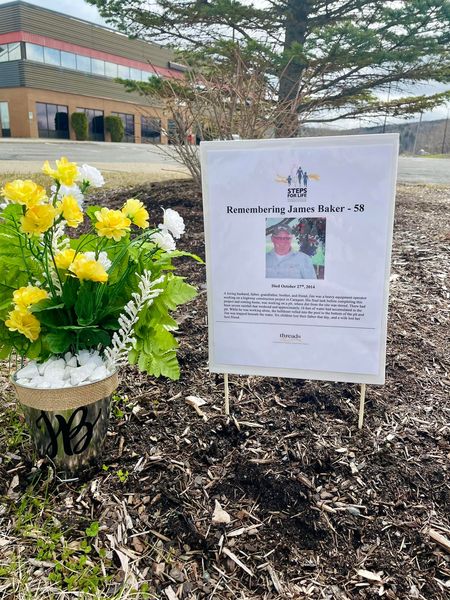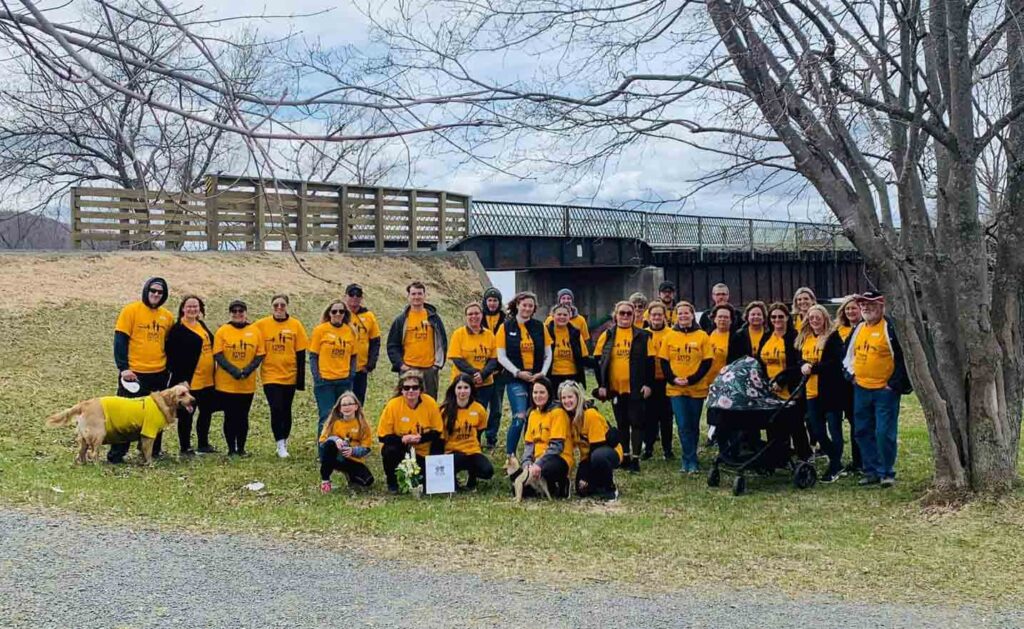
James Baker’s Memory Lane sign at the Baker team’s walk in New Brunswick, 2022.
There’s a chance you missed it at the last Steps for Life walk you went to. Amid the bustle and fun and bright yellow t-shirts, there’s a quiet memorial called Memory Lane. Memory Lane is the heart of an event that has a lot of heart.
Memory Lane is a series of signs, and each sign tells a very brief story of a worker who was injured, made ill, or killed on the job. Each sign is a chance for families to honour a loved one, or for an individual to mark their own lived experience. Each features a photo, a name, a date, and a handful of words to explain what happened that awful day.
Threads of Life creates the signs in consultation with the family – a heart-breaking task. As of this spring, there are 246 Memory Lane signs – 246 stories; 246 faces; 246 attempts to portray the impact a workplace tragedy has on a family and community.
Memory Lane looks a little different in every community where a Steps for Life-Walking for Families of Workplace Tragedy event takes place. Many communities spread the signs out along the length of the 5-km walk route. Some create an area for participants to read the signs and reflect before the walk begins. And every community has a different set of signs, chosen to best represent their region and the families who will walk there.

The Baker family gathers with Jim Baker’s Memory Lane sign at their family’s Steps for Life walk in New Brunswick, 2022.
The signs depict workers who died decades ago and whose families still grieve, workers whose deaths are so recent the families are still struggling through the court system, workers who continue to cope today with the results of an injury years ago, workers who struggled for half a lifetime with an occupational disease, workers whose illness was only identified on the day they died. The 246 signs are so different, but what they all have in common is the smiles. The photos families have included on the Memory Lane signs all show regular people in a moment of happiness – smiling for a school photo, posing with friends, at their jobs, on mountains, on boats, in gardens, holding babies. It’s those smiles that bring home the enormity of the loss.
This year when you’re at your Steps for Life walk, take some time to read those signs and look at the pictures. If you’re holding your own event, you can spend a moment before or after, watching the video of this year’s newest Memory Lane signs.
We know 246 stories are only a tiny drop in the ocean of loss caused by workplace tragedies across this country. But through Memory Lane, Threads of Life families intend not only to remember their loved ones, but also by sharing their stories in such a public way, they want to save other families from what they’ve experienced. They want even one person to see that sign and decide to improve safety at their workplace, or work more safely themselves. That’s where the hope comes in.
If you’d like to help Threads of Life families honour their experiences, prevent future tragedies and build hope, register today for Steps for Life.
- The State of Safety in Canada, 2024 - May 23, 2024
- Yes, you are making a difference. Thank you so much. - May 16, 2024
- Meet one of the families you’ll help through Steps for Life - February 1, 2024

 Find Support
Find Support Donate
Donate